The iOS 6 Review: Maps Thoroughly Investigated and More
by Brian Klug & Saumitra Bhagwat on September 19, 2012 2:21 PM ESTMaps in iOS 6
With Apple’s iDevice lineup, vertical integration has been a constant theme. In iOS 6, this trend continues, even if the motivations are a bit more contrived than a desire to further bring more of the iOS experience under Apple’s control. The drive this time is a souring relationship between Apple and Google which has been in the making for some time now. To a broader extent, the Maps.app experience on iOS has been aging for a while with no clear party to blame. iOS 5 lacked turn by turn navigation, 3D buildings, higher resolution map tiles or vector roads, and other modernizations that have been part of the Android mapping experience for quite a while. That is, until now.
With iOS 6 Apple moves to a solution completely detached of Google, and for the most part brings functionality back up to parity with the competition. The features I touched on already are the main highlights of the new Maps.app experience, as iOS 6 now includes: turn by turn navigation with voice guidance, fully textured 3D buildings, and vector roads. Most of the things users have come to expect from Maps.app remain as well, including three separate views: standard, satellite, and hybrid. Those almost don’t need explanation: standard is the typical solid colored region mapping paradigm we’ve grown accustomed to with vector roads, and points plus regions of interest, satellite includes purely aerial or satellite imagery, and hybrid overlays vector maps and points of interest on the satellite view. Nevertheless there are some things missing from the new Maps.app which we will touch on later.
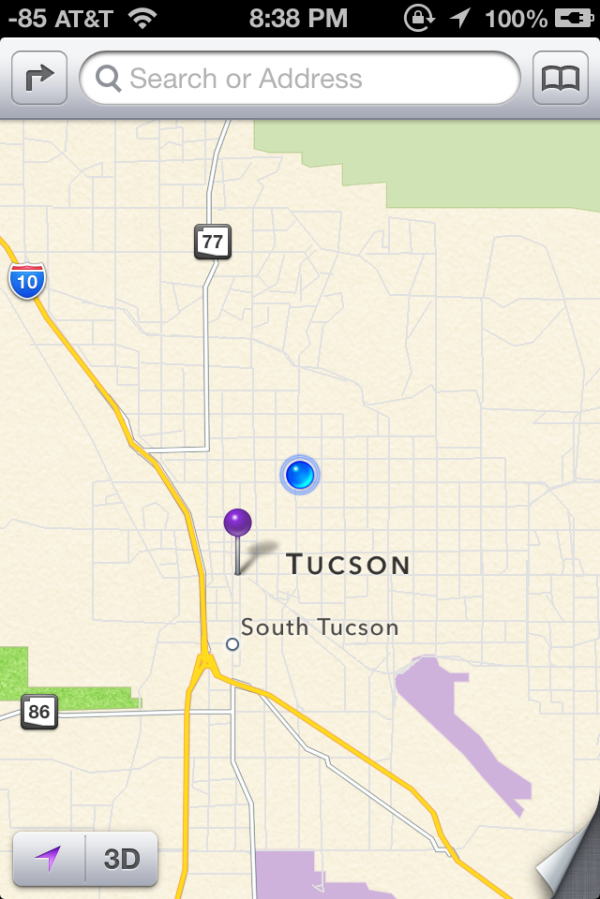
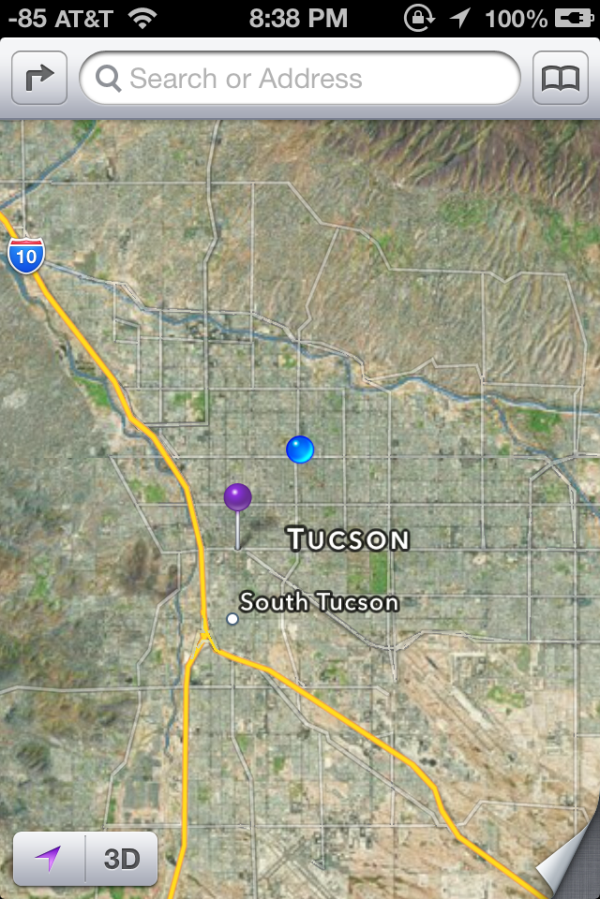
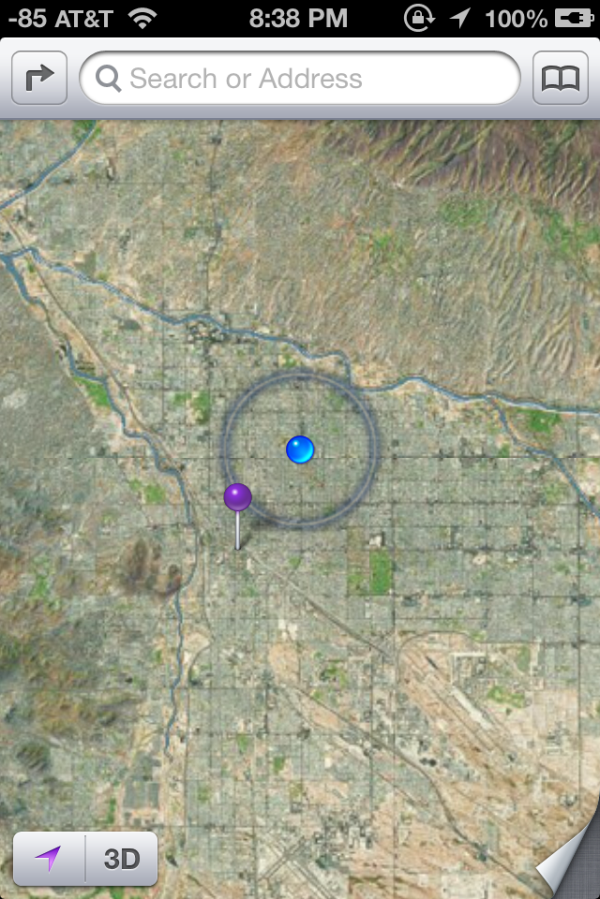
Left to Right: Standard, Hybrid, Satellite
The amount of complexity in moving to a different mapping data source is not something to underestimate. Over the years, Google has built out an extraordinary mapping product with the conjunction of their own street view fleet (which collects both location data, driving conditions data, and a full two pi steradian sphere of imagery), and an even larger set of data contributed by individual handsets reporting back driving conditions which is aggregated into traffic data. Google also made some acquisitions of its own back in the day to catalyze its own Google Maps experience, and at present it is the 9000 pound gorilla for maps.
Most users don’t realize this, but this traffic data is often statistically derived and crowdsourced using data from handsets in areas where in-road inductive sensors aren’t installed. The mobile space has already seen one major battle over who gets WiFi location trilateration data (Skyhook, Apple, or Google) and this traffic data often comes back with WiFi location data as well if the interface is turned on. For traffic data, Apple has begun building out its own dataset with the same approach – by crowdsourcing the velocity vector from iOS 6 devices that are in motion. If you plug your handset into a car charger and have the setting ticked under System Services, you’ll notice “Traffic” showing a purple location services icon while rolling around town. It’s obvious to me that Apple is aggressively collecting data to build its traffic database and get close to parity with Google.
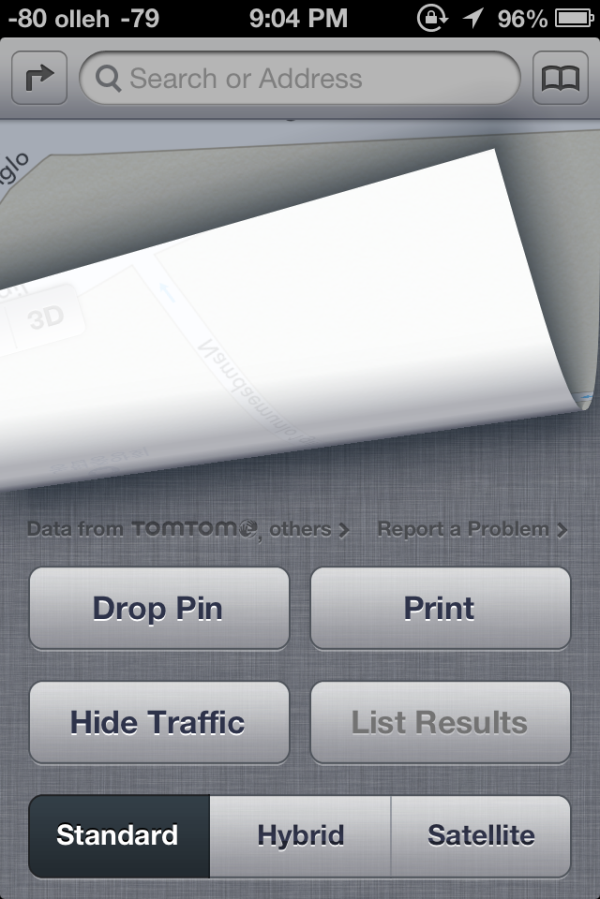
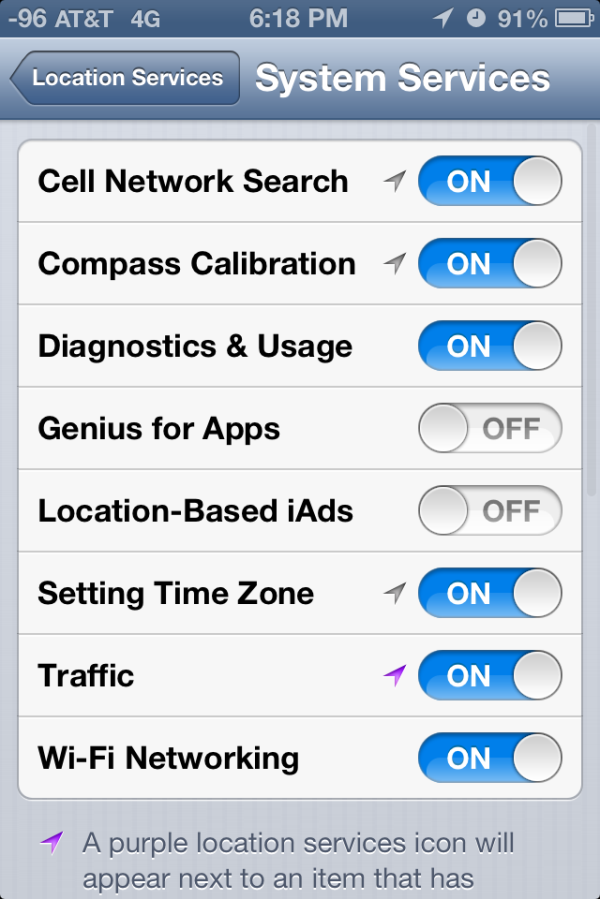
Maps.app settings (Left) showing data from TomTom and link, (Right) Traffic data aggregation in progress while driving around (purple location services icon)
For iOS 6 maps, Apple moves to a variety of data sources beyond what’s in their in-house collection, and for the most part they’re disclosed on the acknowledgements page under settings on iOS 6. There are obviously a few different components to the whole maps product: the road data itself, aerial, satellite, and building textures; business and point of interest listings; and finally reviews. If you look at that acknowledgements page, you can back out a mapping between data sources and the components they contribute. The names have already been pretty well discussed: TomTom, Acxiom, AND, CoreLogic, DigitalGlobe, DMTI, Intermap, Urban Mapping, Waze, Yelp, Flickr, NASA, OpenStreetMap, US Census, US Geological Survey, and the US National Mapping Agency. There are 24 different sources whose data is aggregated together into iOS 6 maps, at least in my region with my acknowledgements page. Apple has also acquired Placebase, Poly9, and C3 Technologies for adding to its own in-house maps team.
The other component is the 3D polygons and textures for terrain and buildings. Terrain elevation data comes from regional government data such as USGS, but for cities and higher resolution terrain data there’s one more key player. That player is C3 Technologies, a company Apple acquired which was an offshoot of SAAB AB. The polygons and textures are generated computationally by taking many aerial photos from small aircraft with a small swath size. For Apple, there are undoubtably some buildings which have seen hand massaging of geometry and textures, it’s in the vast majority of otherwise normal buildings that we can use to gauge quality.
This is an interesting contrast to Google’s 3D dataset, which started out supporting 3D buildings with contributed 3D Sketchup models that were manually built and submitted to Google Earth. After that, Google began also computationally deriving buildings using the isotropic aerial view, and further hand massaging trouble buildings.
If that all sounds complicated, it’s because it is. GIS (Geographic Information Systems) are a science in and of themselves, and the complexity and investment involved with Apple completely managing their own product is nothing to be underestimated. The fact that Apple is willing to not only move to, but also maintain their own GIS should emphasize to what lengths Apple is willing to go to distance themselves from reliance on Google.
What iOS 6.0 maps does away with are the few things that Apple and its data partners can’t yet replicate: street view, and routing on public transportation. For street view, you’re basically out of luck, and users will have to use a standalone Google Maps application in the future which hopefully includes this functionality. I’m told that Apple views 3D building support as the replacement for street view's absence. For routing, Apple is going to rely on 3rd party application support to provide public transportation routing data. Searching for directions and selecting the bus or public transport icon will bring you to a routing apps screen, which will be divided into installed routing applications and suggestions from the App Store based on your region. These will then hand a token back to the Maps app relevant data.

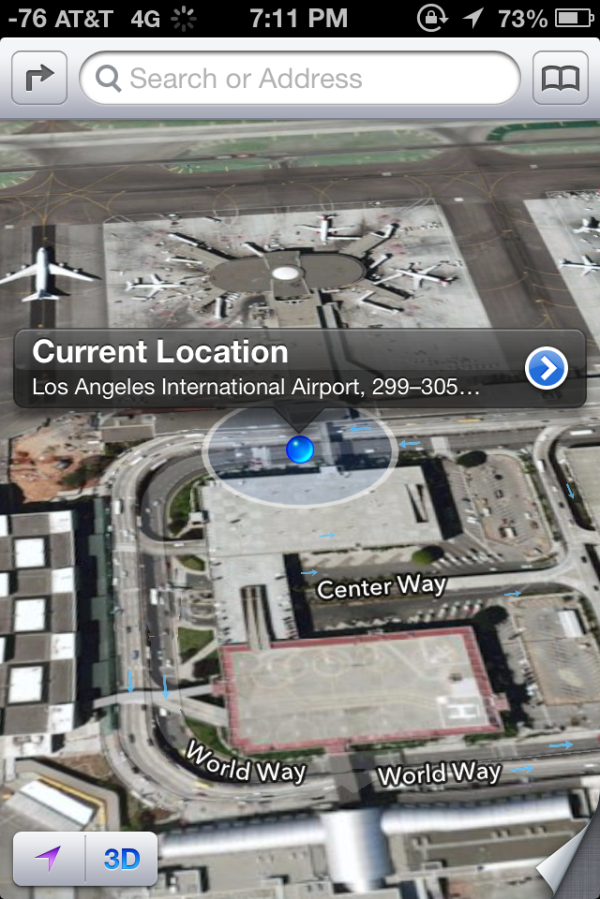
Routing showing toll road notification (Left), current location popup (Right)
So enough about all this theory and what the framework is like, how does the new iOS 6 Maps application actually work? Well, evaluating that whole experience requires us to break down the features into a few different areas.
The overall maps interface changes dramatically from iOS 5. The new iOS 6 maps interface includes a very different appearance or base layer, and again vector roads and street labels. In iOS 5, maps were previously served as texture tiles and scaled appropriately for different zoom levels. While the Google Maps for Android interface includes a combination of vector maps at some zoom levels and texture tiles at others, iOS 6 moves to an entirely vector approach for roads and graphics in the Standard map layout at every zoom level. In hybrid mode, there are vector roads drawn atop texture tiles, and in Satellite mode you get only the aerial tiles. Apple also changed around the unloaded region texture to a black grid with white lines which also scale.
Overall the appearance of Maps in iOS 6 is clean and unique enough to not be a direct ripoff of Google Maps. The jump to vector roads and labels comes with almost no performance hit on the iPhone 4S, where it remains smooth as butter when zooming and panning around. I played with Maps in the standard and hybrid modes on a 3GS and 4 as well, and didn’t see any unacceptable slowdowns. Performance has drastically improved since the first betas.
The quality of aerial textures at this point is perhaps my only major complaint with this new version, as the LoD can be quite low at some zoom levels, and varies wildly by region. Internationally I saw texture resolution jump around between completely unacceptable and quite good. It's obvious that Apple has prioritized home soil since in the USA things are better. Obviously the regions that have 3D building data offer very high resolution textures as a result of custom aerial capture.
This is as far as you can zoom into Seoul, South Korea in Hybrid or Satellite mode, due to low resolution aerial texture assets at present.
There’s no option to include or exclude point of interest labels, instead they appear at appropriate zoom levels automatically in the standard view. About the only option besides changing map modes under the in-app settings fold is inclusion of traffic notes on roads, and an option to print.
New iOS 6 map assets working in Tweetbot for iPhone
From a developer perspective, I'm told and have read that that the switch to Apple-supplied maps is transparent. All the same APIs are implemented with the new maps as in the past, including pins, overlays, the three already mentioned views (standard, satellite, and hybrid), traffic, and points of interest. The apps that I’ve played with which use the maps API work flawlessly so far on iOS 6.


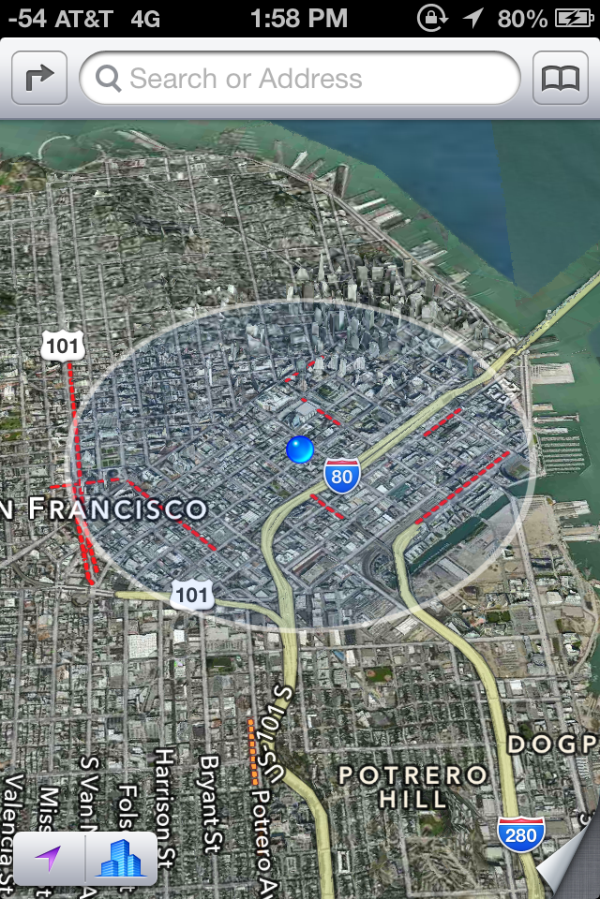
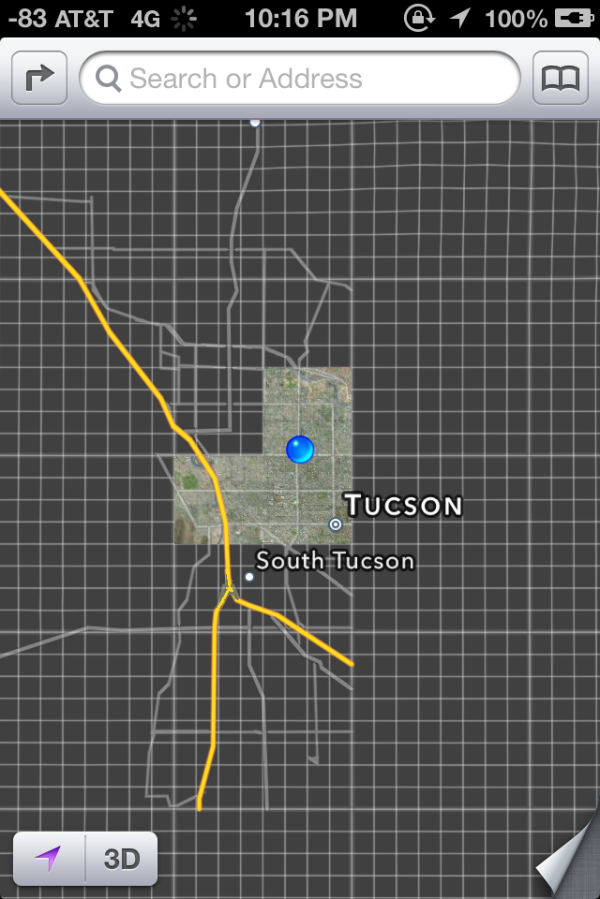
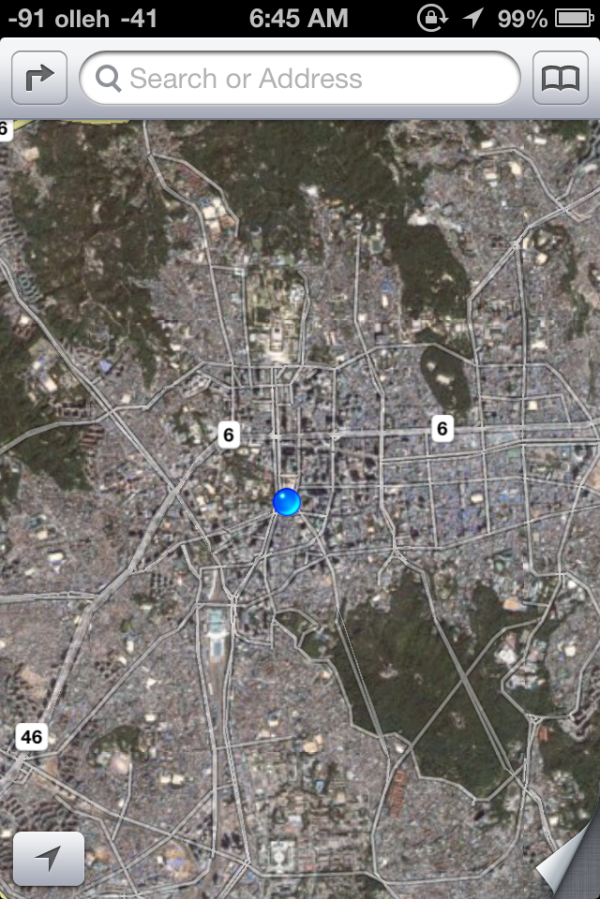
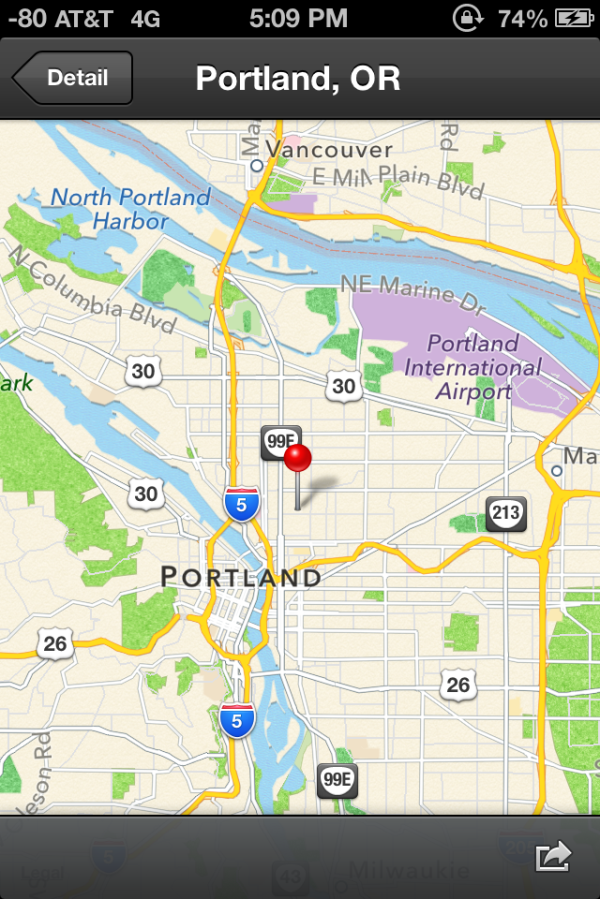








105 Comments
View All Comments
Hyper72 - Wednesday, September 19, 2012 - link
Mobile Safari reports as:Mozilla/5.0 (iPad; CPU OS 6_0 like Mac OS X) AppleWebKit/536.26 (KHTML, like Gecko) Version/6.0 Mobile/10A403 Safari/8536.25
iCab Mobile reports:
Mozilla/5.0 (iPad; U; CPU OS 5_0 like Mac OS X) AppleWebKit/534.46 (KHTML, like Gecko) Version/5.1 Mobile/9A334 Safari/7534.48.3
anandtech02148 - Wednesday, September 19, 2012 - link
gotta disagree with the author on the tablet web browsing.The convenience of web browsing on a tablet is one factor, instant access, easy finger gestures, it should be enhanced in the future so that we do away with the uneccessarry luggage like a keyboard and mouse. Even cutting and pasting have improved, i'm not sure what the author is talking about copying multiple links, mass email etc, the point of Ipad internet browsing is purely entertainment and should be improved upon. IOS does an amazing job on memory management, especially these websites that invades your browser with crazy advertising pop ups. Sinces Android foundation is from Java it might as well be the devil's advocate in crashing and freezing your device.
mikato - Thursday, September 27, 2012 - link
What if you are away from your tablet and are browsing the web, but then you have to stop or you want to save something for later. Then later you want to browse on your tablet instead, and you'd like to pick up where you left off or go back to what you'd saved. It seems like that's the point of the new Reading List syncing feature. How else would you do it besides emailing the links?Some typing is still required when using the web, right? Typing on a touchscreen has improved a lot but is still like a bit like using a keyboard with gloves on. I don't know what my WPM is on a tablet but it must be must be at least cut by 70% or something. I have still occasionally switched to using my desktop when I need to figure something out on the web since it is just much faster. Also, depending on what I'm doing, I may need to look at several web pages, my own notes, or something else why writing an email or a writing something. This is more than just web browsing and although a tablet screen is bigger than a phone and closer to a desktop/laptop, the functionality just isn't there for doing something like that with a tablet. If you're really just "browsing" then a tablet is comfortable for that.
JeremysBrain - Wednesday, September 19, 2012 - link
Only been using nav for 1 day, but the one annoyance that could likely drive me (no pun intended) back to Waze or Navigon is that when the voice guidance comes on, it talks on top of music and podcasts. Other navigation applications will stop playback from other applications, then resume when voice guidance is done.it's frustrating when I'm listening to Brian and Anand, then having to rewind every time new voice guidance comes on in then middle of one of Brian's tangents!
I would like this feature when I'm listening to music, but not when I'm listening to talking heads.
faizoff - Wednesday, September 19, 2012 - link
Just upgraded my iphone 4 to iOS6. The maps app is nowhere close to what google offers so far. I knew there would be issues during the initial release due sheer volume I suppose.Even without turn by turn directions or 3D flyover, the larger direction signs that show up are pretty good for navigation.
The standard maps are very ill configured and barely show any info. I'd have thought that with Tom Tom being a GPS company would have a rather comprehensive database already. My scaling is wrong and many areas are missing. No streetview means by default means I have to wait for google to release their app.
I think I was very impressed with the updates going from iOS4 to iOS5. Going from 5 to 6 however hasn't impressed overall that much yet.
The autobrightness is weird and isn't the same as before for some reason. I had issues with home sharing when it worked flawlessly before, infact was a huge improvement between updates up till now.
I do love the options now present when getting a call.
PPalmgren - Wednesday, September 19, 2012 - link
I'm dissapointed that this article completely glosses over the fact that the maps themselves look like absolute garbage. The way the roads are rendered and the colors used is god-awful compared to google maps, UI being Apple's main selling point. Its hard to tell road types apart close up and hard to read the map in general because of the way its rendered, with thin roads and all. I find it to be a piss-poor implementation and am dissapointed at the soft-white tinted glasses that appeared to be the filter this article went through.MykeM - Thursday, September 20, 2012 - link
I'm comparing what I'm seeing on iOS Map and Google Map- limiting to my milieu since I'm familiar with it- but what I'm seeing is quite comparable.There are a few things on the iOS6 map that seems incomplete. For example, rail track- yes it's much, much narrower than the street but missing the required lines that cut across the track.
But the street itself- the iOS6 version seems better at replicating and differentiating the various width of the main thoroughfares and side-streets. When toggling between the layers of Standard and the Satellite maps, I can clearly see that Google map does a poorer job- it seems to replicate the traffic flow rather than the road itself (resulting in curvier turns when it's actually right-angled). Expectedly, it does a better job at marking various businesses around the neighbourhood. One area where the iOS version will improve over time.
Colour choice and preference are completely subjective but again except for a few choices of colours, both maps seems to me more similar than they're different (Skeuomorphism aside).
robinthakur - Thursday, September 20, 2012 - link
I disagree completely I'm afraid. I was quite worried updating to iOS 6 that the maps would be awful as many early previews of the dev version said, but on my device it runs really fast, we have brilliant 3D flyovers and the maps are accurate and scale nicely. I especially like the rotation and elevation two finger controls like on Android Google maps. Since using G Maps on Android I always though the iOS implementation was a poor cousin, so I think it is good that Apple have finally come up with something comparable and slick which will hopefully grow swiftly. Navigation is much less confusing and busy than the Android version from what I have seen so far. The Siri integration is the icing on the cake.I do miss street view, buit rarely used the public transport navigation bit as Transport for London has a superior service available. At least now when Google release a mapping app it can be as Google want it to be and it will be up to the user whether they want Google tracking their every move and making money off of their browsing/map use.
bunga28 - Wednesday, September 19, 2012 - link
I really enjoy reading the article. It is very informative. Thank you.1. There are 2 authors listed for this piece. I just wanted to know who is the "I," "me," "mine," ... in this. That is very confusing.
2. "at present [Google] literally is the 9000 pound gorilla for maps." Literally? Literally? That is like a friend of mine said to me "I literally haven't seen you for a million years."
ciparis - Sunday, September 23, 2012 - link
Well, considering:1) they do weigh 9000 pounds (or more)
2) at least a few of them strongly resemble a gorilla, so who can say that they aren't?
I don't see the problem. Plus, your friend might just be a time traveller.